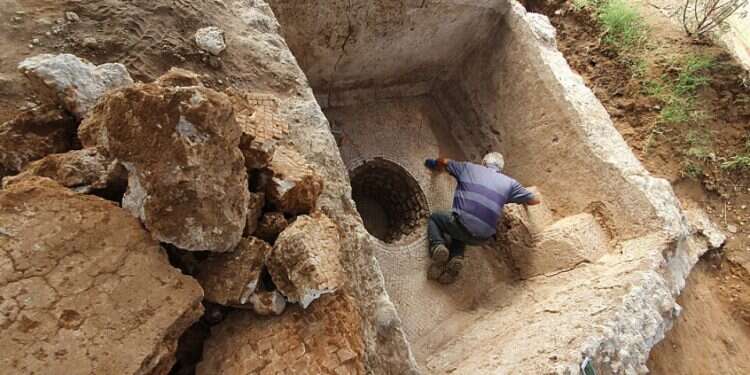Evidence of farming and industrial activity dating back some 1,500 years has been unearthed at an Israel Antiquities Authority excavation in the upper middle-class Tel Aviv suburb of Ramat Hasharon.
Follow Israel Hayom on Facebook and Twitter
The project, initiated by the Ramat Hasharon Municipality in preparation for the construction of a new residential neighborhood, has thus far uncovered a large wine vat, a gold coin, and a bronze chain used to hang a lighting fixture.
"We have discovered evidence of farming and industrial activity that took place here 1,500 years ago, during the Byzantine Era," said Dr. Yoav Arbel, who is overseeing the dig on behalf of the IAA.
"Among other finds, we have unearthed a large wine vat with a mosaic bottom, plastered rooms, and the foundations of a large building that appears to have served as a storage facility and possibly a farm house," Arbel added.
According to the archaeologist, it appears that in Byzantine times, people not only worked the site, but also lived there.

"We have found remains of homes and two large ovens," he observed. Other artifacts uncovered in the excavation include intact clay pottery lamps and serving bowls – both locally made and imported. Some of the bowls feature decorations. Based on the findings, researchers believe that the site was inhabited until the 11th century CE.
"Inside the structures we found fragments of storage jugs and cooking vessels, which appear to have been used by the people who worked the fields here. We also found grinding stones used to grind wheat and barley, and apparently also cooking and medicinal herbs. Some of the stone tools are made of basalt originating from the Golan Heights and the eastern Galilee," Arbel explained.
Video: Assaf Peretz/Israel Antiquities Authority
The excavation also turned up a gold coin that Arbel said was minted in 638 or 639 CE by the Byzantine Emperor Heraclius (Heraklion). One side of the coin features the emperor with his two sons, and the second side depicts a cross on top of Golgotha, where according to Christian tradition Jesus was crucified.
Arbel said that the coin had also been inscribed with a simple inscription in Greek letters, and possibly in Arabic. The inscription appears to have been the name of its owner, who marked it and treated it as a precious object.

Dr. Robert Cole, a numismatics expert with the IAA, said, "The coin contains various information about the end of the Byzantine rule in the Land of Israel and historical events like the Persian invasion and the advent of Islam, information about the symbolic significance of Christianity and paganism, and the local population living in the Land of Israel at that time."
Cole said that another important find was a bronze chain used to hang a lighting fixture that included glass lamps. "Fixtures like these were generally found in churches," he explained.
According to Cole, after the Muslim conquest in the seventh century CE, a glassmaking factory was built at the site, as well as a storehouse. Four large storage jugs have been found in the ruined storehouse, sunk into the floor, and appear to have been used to hold seeds and other goods and protect them from pests and weather.
Ramat Hasharon Mayor Avi Gruber said he was "thrilled" at the finds, and that the city was already working with the developers of the planned Naveh Gan residential project on ways of preserving the discoveries and integrating them into the construction.
"I want every resident to enjoy them and learn about life here in ancient times and the Middle Ages. We're working on a heritage program and this adds another huge angle to life here on this land," Gruber said.
Subscribe to Israel Hayom's daily newsletter and never miss our top stories!




